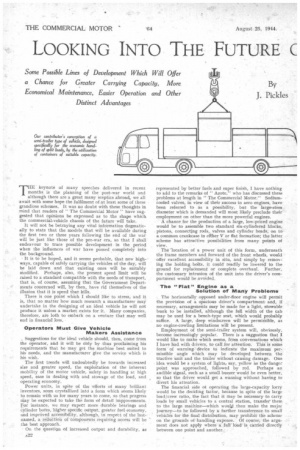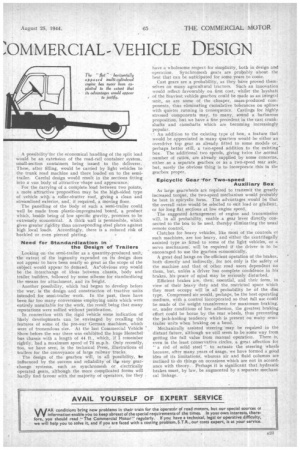LOOKING INTO THE FUTURE C
Page 24

Page 25

If you've noticed an error in this article please click here to report it so we can fix it.
:OMMERCIAL-VENICLE DESIGN
Some Possible Lines of Development Which Will Offer a Chance for Greater Carrying Capacity, More Economical Maintenance, Easier Operation and Other Distinct Advantages
keynote of many speeches delivered in recent months is the planning of the post-war world and although there are a great many sceptics abroad, we all await with some hope the fulfilment of at least some of these grandiose schemes, It was no doubt with these thoughts in mind that readers of " The Commercial Motor " have suggested that opinions be expressed as to the shape which the commercial-vehicle chassis of the future will take.
It will not be betraying any vital information dogmatically to state that the models that will be available during the first two or three years following the end of the war will be just like those of the pre-war era, so that I shall endeavour to trace possible development in the period when the influences of war have passed .completely into the background.
It is to be hoped, and it seems probable, that new highways, capable of safely carrying the vehicles of the day, will be laid down and that existing ones will be suitably modified. Perhaps, also, the present speed limit will be raised to a standard compatible with the needs of transport, that is, of course, assuming that the Government Departments concerned will, by then, have rid themselves of the illusion that it is speed that kills.
There is one point which I should like to stress, and it is, that no matter how much research a manufacturer may undertake in the designing of an ideal vehicle he will not produce it unless a market exists for it. Many companies, therefore, are loth to embark on a venture that may well end in financial loss.
Operators Must Give Vehicle Makers Assistance Suggestions for the ideal vehicle should, then, come from the operator, and it will be drily by thus proclaiming his requirements that he may get the machine best suited to his needs, and the manufacturer give the service which is his wish.
Thefirst trends will undoubtedly be towards increased size and greater speed, the exploitation of the inherent mobility of the motor vehicle, safety in handling at high speed, ease in dealing with and stowage of the load, and operating economy.
Power units, in spite of the .efforts at many brilliant inventors, seem crystallized intci a form which seems likely to remain with us for many years to come, so. that progress May be expected to take the form of detail impieavements. For instance, we may expett more durable bearings and cylinder bores, higher specific output, greater fuel economy, and improved accessibility, although, in respect of the lastnamed, a reduetion of eiamponents requiring access will be the best approach.
On the question of increased output and durability, as
represented by better fuels and super finish, I have nothing to add to the remarks of " Azote," who has discussed these problems at length in "The Commercial Motor." Sodiumcooled valves, in view of their success in aero engines, have been referred to as a possibility, but the large-stem diameter which is demanded will most likely preclude their employment on other than the more powerful engines.
A chance for the production of a large, low-priced engine would be to assemble two standard six-cylindered blocks, pistons, connecting rods, valves and cylinder heads, on to a common crankcase in either V or flat formation; the latter scheme has attractive possibilities from many points ot view.
The location of a power unit of this form, underneath the frame members and forward of the front wheels, would offer excellent accessibility in situ, and simply by removing the bolding bolts, it could readily be lowered to the ground for replacement or complete overhaul. Further, the customary intrusion of the unit into the driver's compartment would be avoided.
The "Flat" Engine as a Solution of Many Problems
The horizontally opposed under-floor engine will permit the provision of a spacious driver's compartment and, if necessary, arrangements may be made for a light, stowable bunk to be installed, although the full width of the cab may be used for a bench-type seat, which would probably suffice. A large, deep windscreen will be permiesible, as no engine-cowling limitations will be present.
Employment of the semi-trailer system will, obviously, become increasingly popular. There is a suggestion that I would like to make which seems, from conversations which I have had with drivers, to call for attention. This is some form of warning device to indicate the maximum permissible angle which may be developed between the tractive unit and the trailer without causing damage. One idea would be a system of lights, say, yellow as the danger point was approached, followed by red. Perhaps an audible signal, such as a small buzzer would be even better, so that the driver would get a warning without having to divert his attention.
The financial side of operating the large-capacity lorry would be the deciding factor, because in spite of the large load/crew ratio, the fact that it may be necessary to carry loads by small vehicles to a central station, transfer' them to the large maChine—which woulel then make the major journey—to be followed by a further transference to small vehicles for the final distribution, may prohibit the scheme on the grounds of handling expense. Of course, the argument does not apply where a full load is carried directly between one point and another.. A possibility for the economical handling of the split load would be an extension of the road-rail container system, small-section containers being issued to the deliverer. These, after filling, would be carried by light vehicles to the trunk road machine and there loaded on to the semitrailer. Careful design would result in the sections fitting into a van body of attractive-shape and appearance;
For the carrying of a complete load between two points, a more attractive proposition may be the high-sided type of vehicle with a roller-shutter roof, giving a clean and streamlined exterior, and, if required, a moving floor. The panelling of the body of such a semi-trailer could well be made from plastic-impregnated board, a product which, beside being of low specific gravity,, promises to be extremely economical. A thick wall is permissible, which gives greater rigidity than corresponding steel plates against high local loads. Accordingly, there is a reduced risk of buckled or even pierced plating.
Need for Standardization in the Design of Trailers
Looking on.the semi-trailer as a quantity-produced unit, the extent of the ingenuity expended on its design does not appear to have been nearly so great as the scope of the subject would appear to demand. An4obvious step would be the interchange of ideas between chassis, body and trailer builders, followed by some scheme for standardizing the means for attachment, and its height.
Another possibility, which had begun to develop before the war, is the design and construction of tractive units intended for semi-trailer work. In the past, there have been far too many conversions employing units which were entirely unsuitable for the work, the result being that many reputations were sullied without justification.
In .connection with the rigid vehicle some indication of likely develogments can be envisaged by recalling the features of some of the pre-war 'German machines, which were of tremendous size. At the last Commercial Vehicle Show before the war there was exhibited the huge Henschel bus chassis with a length of 44 ft., which, if I remember rightly, had a maximum speed of 75 m.p.h. Only recently, too, we have seen, in the technical Press, illustrations of trailers for the conveyance of large railway trucks.
The design of the gearbox will, in all possibility, be influenced by the success and reliability of the easy gearchange systems, such as synchromesh or electrically operated gears, although the more complicated forms will hardly find favour with the majority of operators, for they
have a wholesome respect for simplicity, both in design and operation. Synchromesh gears are probably about the best that can be anticipated for some years to come.
Cast gears are a probability, as they have proved themselves on many agricultural tractors. Such an innovation would reflect favourably on first cost, whilst the layshalt , of the heaviest vehicle gearbox could be made as an integral unit„ as are some of the cheaper, mass-produced components, thus eliminating cumulative tolerances on splines with quietei running in consequence. Castings or highly stressed components may, to many, sound a barbarous proposition, but we have a fine precedent in the cast crankshafts and camshafts which are becoming increasingly popular.
An addition to the existing type of box, a feature that would be appreciated in many quarters would be either an overdrive top gear as already fitted to some models or, perhaps better still, a two-speed addition to the existing' box: The additional two speeds, giving twice the normal number of ratios, are already supplied by some concerns, either as a Separate gearbox or as a two-speed rear axle, hut, surely the obvious thing is to incorporate this in the gearbox proper.
Epicyclic Gear-for Two-speed Auxiliary Box
As large gearwheels are required to transmit the greatly increased torque, the two-speed mechanism would probably be best in epicyclic form. The advantages would be that the overall ratio would be selected to suit load or gradient, or for long flat sections at low engine speed. The suggested irrangement of engine and transmission will, in all probability, enable a gear lever directly connected to the box to be used, thereby eliminating the usual remote controL
Clutches for heavy vehicles, like most of the controls of such machines, are too heavy, and either the centrifugally assisted type as fitted to some of the light vehicles, or a servo mechanism will be required if the driver is to he encouraged to use the gearbox economically. A great deal hangs on the efficient operation of the brakes. both directly and indirectly, for not only is the safety of the machine and that of other road users dependent on them, but, unless a driver has complete confidence in his brakes, his .peace of /Rind may be seriously disturbed. Efficient brakes are, then, essential, and their form, in view of their heavy duty and the, restricted space which they must occupy will in all probability be of the disc type. Compressed air would, perhaps, be the hest operating medium, with a control incorporated so that full use could be made of the weight transference for maximum braking, or, under conditions of low adhesion, the greatest braking effort could be borne by the rear wheels, thus preventing the jack-knifing tendency which is present on many semitrailer units when braking on a bend.
Mechanically assisted steering may be required in the distant future, although we still seem to be some way from getting the full value from manual operation. There is, even in the least conservative circles, a great affection for " a rOd -of solid steel " to actuate the steering wheels because, after many years of usage, we have formed a good idea of its limitationi, whereas air and fluid columns are inclined to do things on occasions which are not in accordance with theory. Perhaps it is significant that hydraulic brakes mrust, by law, be augmented by a separate mechanical linkage.




















































